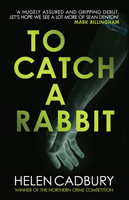 In my debut novel, To Catch a Rabbit, out with Allison and Busby, (SHOTS' review), I have created a young police community support officer, Sean Denton, who steps way outside his pay grade to solve the death of a trafficked prostitute. As it’s my first book, I have packed in several real world issues that bother me, how we value those at the bottom of the societal pile being one of the most pressing. It is an issue I have come back to in my second book, Bones in the Nest (due out in July 2015), and it’s definitely a concern in the third book, which I’m writing at the moment, although with certain complications this time. Sean Denton is young and not yet cynical, and naturally champions the underdog. In this sense he clearly shares aspects of my own personality (except the ‘young’ bit, unless it really is true that you’re only as young as you feel).
In my debut novel, To Catch a Rabbit, out with Allison and Busby, (SHOTS' review), I have created a young police community support officer, Sean Denton, who steps way outside his pay grade to solve the death of a trafficked prostitute. As it’s my first book, I have packed in several real world issues that bother me, how we value those at the bottom of the societal pile being one of the most pressing. It is an issue I have come back to in my second book, Bones in the Nest (due out in July 2015), and it’s definitely a concern in the third book, which I’m writing at the moment, although with certain complications this time. Sean Denton is young and not yet cynical, and naturally champions the underdog. In this sense he clearly shares aspects of my own personality (except the ‘young’ bit, unless it really is true that you’re only as young as you feel).
I’m not sure if readers worry that I am a woman writing a central character who is a man, but I am often asked whether any of my characters are based on real people. I have heard Val McDermid say that there is a dataset of people we meet in our lives and it is from this dataset that we draw the knowledge to create fictional characters; how could it be any other way? The characteristics of several people will, of course, be blended to serve the story. Elements of people I have known will find themselves into made-up bodies, speech patterns, belief systems, but if I followed the maxim ‘only write about what you know’ and I only used real people in their entirety, the work would be much less interesting (and I would probably be sued). A writer has to imagine, and those imaginings will be based on another dataset, the dataset of emotional experiences. I have never been threatened with a knife, for example, but I have witnessed a violent attack at close quarters, and although I was not the victim, it isn’t a huge leap to put myself in his shoes and imagine how that might have felt.
There is another way in which reality makes its presence felt in fiction, and that is in the question of research. I first came across the idea of brothels in temporary vehicles when I read a newspaper article about a man convicted of running prostitutes from a caravan on the A1. It sat in the back of my mind and a few years later found its way into To Catch a Rabbit. This kind of unintentional research is sometimes called inspiration. Intentional research, for me, comes later, where I’ve written something for the plot or for the flow of the piece and I need to check whether it’s feasible or believable. When I was working on To Catch a Rabbit I discovered that a friend-of-a-friend had a mum who was a PCSO, and she very kindly read the manuscript. She pointed out a procedural inaccuracy that nearly scuppered the whole plot. When Sean finds the body (this is not a spoiler alert as it happens in the first two pages) he would not normally, as a PCSO, have anything to do with the next part of the process. So I asked myself, if those are the rules, for what reason might someone break those rules? I have worked in many different, rule-bound institutions, including schools and prisons, and this gave me a more tantalising issue to grapple with: people doing what they’re supposed to is not dramatic; whilst people who break the rules are, especially when they are the ones who are tasked with upholding the rule of law in the first place.
The balance of reality and imagination is crucial to contemporary crime fiction. We cannot create a new world, like science fiction writers do, but we might shed light on a world that is on the edges of the one our readers are living in. Little Red Riding Hood works because we are scared of the dark woods, and who might be lurking there. What’s the worst thing that can happen? Well, a wolf could eat a grandmother. When she is saved, and the wolf is dead, we feel reassured. If you are naturally quite an anxious person, this imagining of worst-case scenarios is very familiar. ‘That child isn’t holding her mother’s hand, she might step out and that lorry might hit her.’ If you think like this, you are thinking like a crime writer. If you lie awake listening to the creakings of your house, and visualise intruders on the stairs, and wonder how they got in, you’re thinking like a horror writer. The next time someone asks me where I get my ideas from, I might just say, from lying awake worrying.
The strangest thing that happens to writers, and I’m not alone in this, is finding that we’ve made something up, and it is now happening in the real world. Since writing To Catch a Rabbit and Bones in the Nest, the behaviour of certain police officers, and the very police force I’m writing about, have been in the public eye in ways I did not predict, and that I had thought were the product of my imagination. But perhaps if we’re perceptive and make connections between the events we see in the papers, or the things that have happened to people we know, or that we ourselves have experienced, then we are likely to concoct fictional worlds which operate along very similar lines to reality.
Of course, the craft and techniques of writing have to be deployed and the real world has to bend to the rules of the novel. When the path between truth and fiction divides in the crime world, we leave the messy, unsatisfactory reality of broken lives and terrible mistakes to one side. The structure of the novel leads the reader to a neater conclusion, to what American grief therapists call ‘closure’. In my experience real grief is never closed, and in practice the fiction writer doesn’t entirely close off all the loose ends and questions for the reader. For one thing, they want the reader to come back. So they build in the signals to indicate they’ve come to the end of this particular story, like the finale in a musical which reminds us that soon we will be outside on the wet pavement, trying to find a taxi, but the writer hopes that the reader will still be humming the tune, and will want to come back soon into that not-real world, and spend a few more hours in it, perhaps trying to make sense of their own, messier reality.
 To Catch a Rabbit
To Catch a Rabbit
Allison & Busby
RRP: £7.99 - PBK
Released: January 22, 2015

i need to cheat on my girlfriend
go i cheated on my girlfriend and i want her back
coupon for bystolic
click forest patient assistance
cialis free sample coupons
click free prescription drug cards
citalopram hydrobromide high
read citalopram hydrobromide and alcohol
imodium vidal
site imodium sirop
pletal y cirugia
peider.dk pletal 100 mg precio
ventolin prospecto
click ventolini cali
addiyan chuk chuk
addyi addyi menopause
naltrexone implant australia
open who can prescribe naltrexone
low dose naltrexone for pain
open naltrexone challenge